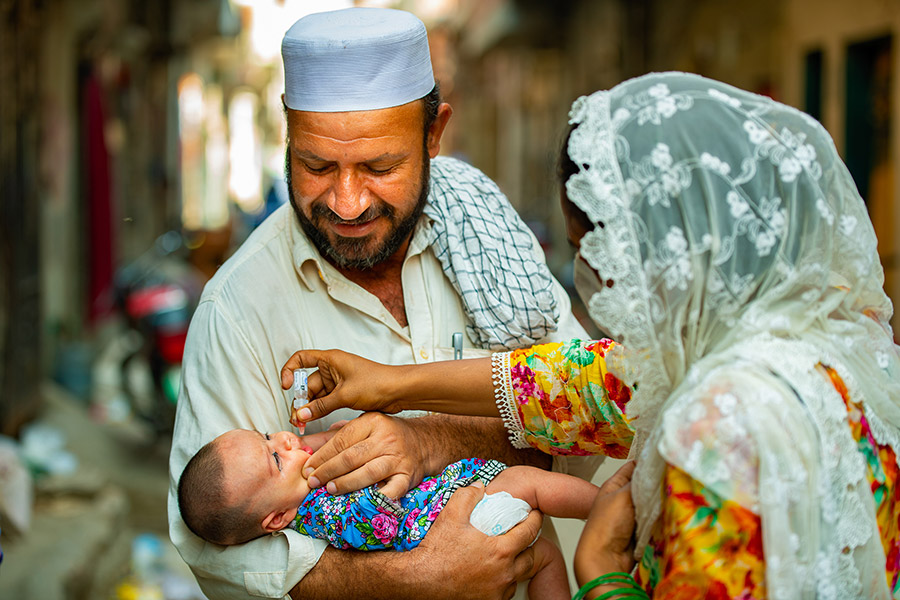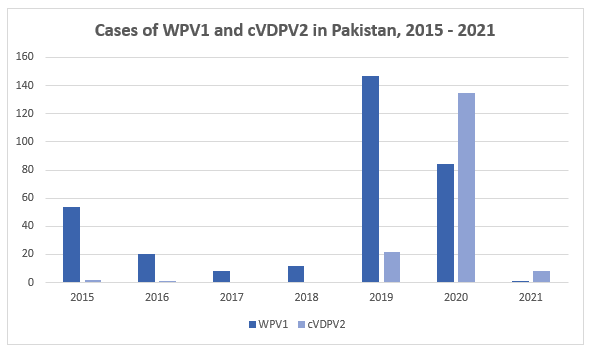 A young boy is vaccinated in Maraghzar Colony, Lahore. Photo credit: Syed Mehdi Bokhari
A young boy is vaccinated in Maraghzar Colony, Lahore. Photo credit: Syed Mehdi Bokhari
Pakistan is one of two countries where polio remains endemic. Together with Afghanistan, the neighbouring countries form one epidemiological block.
Following a resurgence in the number of children paralyzed by WPV1 in 2019, Pakistan reported just one case of the virus in 2021. The proportion of positive environmental samples also decreased. The programme has achieved similar results in the past but the current significant decrease in the virus found in the environment is unique.
Eight children were paralysed by cVDPV2 in 2021, a significant decrease from 135 children in 2020. The 2020 outbreak centred in areas with low routine immunization coverage and an inherent absence of immunity. Decreased immunity levels were also exacerbated by poor water, sanitation and hygiene conditions in communities and the high prevalence of malnutrition.

WHO, working alongside GPEI partners, provides technical support to the polio eradication programme in Pakistan at federal, provincial and district level including support to surveillance, cold chain management, training of more than 300,000 frontline workers and health managers, reporting and data management, operations and communications.
The Polio Oversight Board travelled to Pakistan twice in 2021, in June and November. The delegation visited field locations, viewing the work of the programme and meeting with at the forefront of eradication. The delegation noted the impressive progress and commitment made by the Government of Pakistan and its partners towards interrupting the transmission of wild poliovirus.
Responding to dual WPV1 and cVDPV2 transmission
To better reach high-risk populations, the programme is recruiting polio workers from the same communities affected by the poliovirus, as well as developing improved tools for assessing and addressing their needs. Polio activities are being integrated into priority social programmes to offer communities a holistic package of basic services and improve population immunity. Basic health services are also being integrated into vaccination campaigns with Ehsass, Pakistan’s flagship social support programme, to reinforce the value of the polio programme to communities by addressing their health needs in a more holistic manner.
Based on epidemiological data, the programme is continuously re-defining its geographic focus to ensure interruption of transmission. In 2021, the programme pivoted its focus to risk areas including core reservoirs, central Pakistan and southern Khyber Pakhtunkhwa. An extensive network of social mobilizers is working with community leaders in these areas to identify root causes of vaccine hesitancy, combat misinformation and tackle refusals.
To create an enabling environment, the programme continues to build alliances with individuals, civil society, and the public and private sectors including the Pakistan Islamic Medical Association, the Pakistan Paediatric Association, the Pakistan Cricket Board and several foundations to engage key influencers to promote polio vaccination.
In 2021, National Immunization Days were held in January, March, September and December, targeting over 40 million children under five years of age in each round. Supplementary vaccination activities were also held in targeted locations in June, August and December. Frontline polio staff were thoroughly trained on COVID-19 protocols and preventive measures which were followed during household and field visits, and vaccination.
Polio surveillance in Pakistan
From the most remote villages to its largest cities, Pakistan’s polio surveillance system has the capacity to find the poliovirus wherever it exists.
Acute Flaccid Paralysis (AFP) surveillance remains a core tool for polio eradication in Pakistan. While the global standard is a minimum of two non-polio AFP cases per 100,000 population below 15 years, Pakistan has systematically increased this rate from 6.8 in 2015 to more than 13.4 as of June 2021. The AFP surveillance system is complemented by environmental surveillance which helps to find the poliovirus as it exists in various forms such as sewage water. Pakistan has the largest environmental surveillance network in the world, with 65 sites strategically located in 44 districts across the country.
The regional reference laboratory continues to test stool and environmental samples to ensure timely detection of the virus. An average of over 8,800 stool samples and 350 environmental samples are tested every three months.
An external surveillance review was undertaken in October 2021 to independently assess the surveillance system in Pakistan. The reviewers concluded that the system is capable of detecting any poliovirus circulation, noting the need for the programme to remain hyper-vigilant against the historic low level of virus detection in the country. The Eastern Mediterranean Regional Office, GPEI Polio Hub and WHO Pakistan are working together to develop an action plan to implement the review’s recommendations.
Pakistan Polio Eradication Programme


